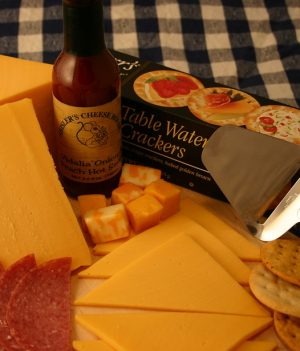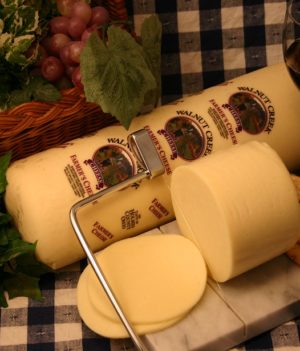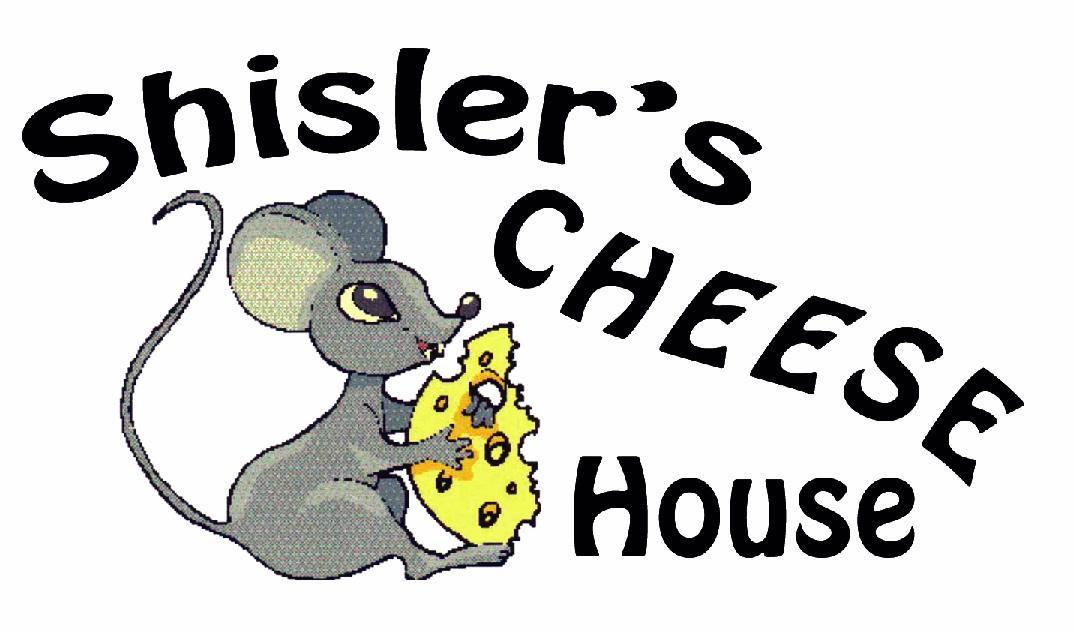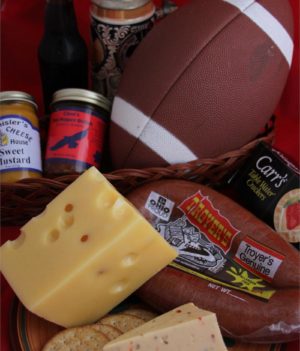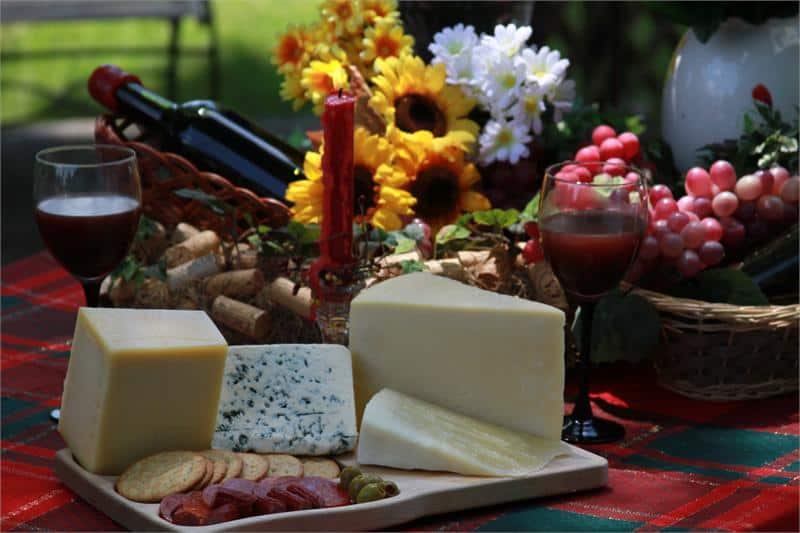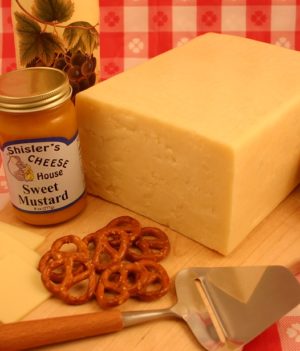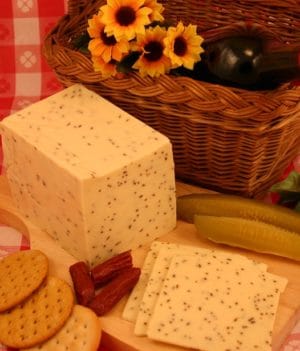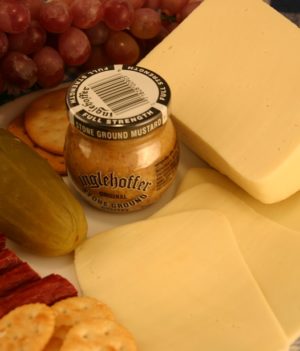Author: millieepona
It’s National Cheeseburger Day!
Today is National Cheeseburger Day! We thought it was a great time to bring you some facts about cheeseburgers and some ideas for celebrating.
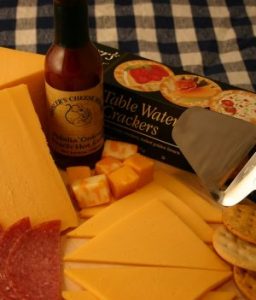
When was the cheeseburger invented?
While the exact date of the invention of the cheeseburger is unknown, it was created in 1926 by Lionel Sternberger in Pasadena, CA at his father’s sandwich shop called the “Rite Spot.” The invention of the burger is hotly contested, so we won’t wade in on that one!
What cheese is best?
Now, this is an age-old debate: which cheese should you put on your cheeseburger?
The classic is probably American Cheese. Our Sharp American Cheese is produced in Wisconsin. American Cheese is orange, yellow, or white in color and mild in flavor, with a medium-firm consistency, and melts easily. It has traditionally been made from a blend of cheeses, most often Colby and Cheddar. It originated when British colonists began making cheddar after they arrived in America. By 1790, American cheddars were being exported back to England and the British referred to them as “American cheese” or “Yankee cheese”. Post-Revolution Americans promoted this usage to distinguish the exports of their proud new nation from European cheese.
Swiss cheese is another great choice. Our locally made Amish swiss cheese closely resembles the original Swiss Emmental Cheese and has a nutty, bittersweet taste that pairs well with beef burgers. The process of making Swiss cheese involves natural bacteria consuming the lactic acid in the cheese. This releases carbon dioxide gas, which forms bubbles that become the holes in the cheese. These are often referred to as “eyes”.
For something a little more unusual that packs a flavorful punch, try adding a slice of blue cheese. These cheeses have had Penicillium cultures added, creating dark blue or blue-grey veins throughout the cheese and a sharp, salty flavor.
Our final exciting choice is to add a spicy cheese! We love our Hot Habanero Cheddar. It’s a combination of vintage aged cheddar, habaneros, and jalapenos. It adds a great southwestern flavor to your burgers. Be careful though, it’s a spicy one! Try a little before you pile it into your bun.
Which cheese would you pick? Have we missed out one that you love to put on your cheeseburgers?
How should you celebrate?
- Get a free burger! All over the country, restaurants are offering free or discounted cheeseburgers to celebrate the day. Search for one in your city and head over!
- Make cheeseburgers from scratch. You might have never done this but it’s a surprisingly easy thing to make. You can find recipes for burgers from the simple to the sublime online, but at its core, it is simply beef and some seasoning, brought together into a patty. Of course, you’ll want to add a slice of cheese today!
- Have a cheeseburger competition. Grab your burgers and lots of different types of cheese. See who can come up with the best combination. You pick the reward!
We hope that you all have a fun National Cheeseburger Day. Let us know how you’re celebrating in the comments!
Cheese Glossary: The Letter F
The cheese glossary continues with the letter F!

Farmer’s cheese
Farmer’s Cheese is a mild, unripened white cheese made by adding rennet to cow’s milk. When the milk coagulates it separates into solid curds and liquid whey, which is drained off. The result at this stage is sometimes referred to as pot cheese. Further pressing out of the moisture results in a more firm and crumbly Farmer’s Cheese. It is often used in recipes including Blintzes and Pierogies. One popular local use is to lightly fry Farmers Cheese and eat it in a sandwich, but our favorite is to slice it very thin and roll it with our flavorful smoked meats. It is also known as a cheese that has fewer calories and less fat and cholesterol than many other cheeses.
Farm-made
This means a cheese that has been made on a farm with that farm’s own milk. If you have a chance to try a farm-made cheese it can often offer a specific taste unique to that area. This is also called farmhouse, farmstead, or fermier cheese.
Fermentation
The process of converting carbohydrates to alcohol or organic acids using microorganisms including bacteria and yeasts. In cheese, the carbohydrates are converted to organic acids.
Fermented
This can be used to describe the smell of cheese as having the quality of fermented alcohols.
Feta
A Greek cheese made from goat’s and sheep’s milk. It is a fresh cheese that is usually sold submerged in brine. It has a salty, tangy taste and a high moisture content. It is often used in salads and combines well with fruit, but can also be baked.
Finish
This can refer to several things:
- The ripening process involved in cheesemaking. Finishing methods include spraying the surface with Penicillium, washing rinds or turning the cheese.
- The packaging of cheese. This might include hard, natural rind, a bandage of cheesecloth and wax or vacuum packaging.
- The aftertaste of cheese, just as ‘finish’ is used in descriptions of wine.
Firm
Cheese varieties which are relatively inelastic and unyielding in texture. Firm cheeses include Cheddar and Romano Pecorino.
Force Ripening
Speeding up the ripening of a cheese by using a warmer environment than normal to naturally ripen the cheese or by changing the enzymes added.
Formaggio
The Italian word for cheese!
Fresh
Typically these are cheeses that have not been aged or cured. They usually have a delicate, tangy flavor from the lactic curdling. Fresh cheeses can be better for melting as they have so much moisture. These include Ricotta and Mascarpone. Some cheeses that are described as ‘fresh’ have been cured for a very short time, such as Feta.
Friable
This means a cheese that crumbles easily.
Fromage
The French word for cheese!
Fruity
A description of the sweet, fragrant aroma or flavor of some cheeses.
As always, let us know if you have any questions or words for us to define in the cheese glossary in the comments below.
Our favorite Shisler’s Cheese House reviews
We absolutely love our customers at Shisler’s Cheese House. We hope that you love our products and that you enjoy coming to see us in store or shopping online. Did you know that our Facebook page is full of Shisler’s Cheese House reviews?

Today we have put together some of our favorite reviews for you to read. If you haven’t already, head on over and like us on Facebook! You’ll get up to date on our latest news and see all of our blog posts over there. You can also leave us a review; we’d love to hear what you think about us.
One of the best cheese mongers in northern Ohio! Rita knows what she’s doing. If you have a weekend out or a couple of days to explore this beautiful part of Ohio you must visit this shop. – Christy
Love this store. They say good things come in small packages. Well, this is one of the best. So much goodness in that little store and they carry my two favorite foods… cheese and chocolate! Rita and her staff go above and beyond to be sure each customer leaves happy and satisfied. – Cheryl
Great selection of quality food and chocolates!!!! I’ve never been to the store, as we live out of state, but have always been extremely pleased with the quality products and shipping that allows items to stay cold, even to Florida. Will continue to order our holiday treats from here. – Jennifer
We live in Maryland and we are originally from Massillon but every year we order Ohio Swiss Cheese from Shisler’s Cheese House, so we always have a little Ohio on our table. – Mary
At Shisler’s, our employees are trained to provide nothing less than outstanding service. Whether you choose to do business at our brick and mortar or online store, your satisfaction is 100% guaranteed. Beyond insisting that our employees provide outstanding service, we do our best to provide a pleasant work environment for them, in which those service habits develop naturally. If you ever receive anything less than outstanding service, please let a member of our senior staff know and give us the opportunity to correct the situation.
Let us know what you think of our products and service in the comments below or over on Facebook!
Cheese Glossary: The Letter E
It’s time for the letter E in our cheese glossary!
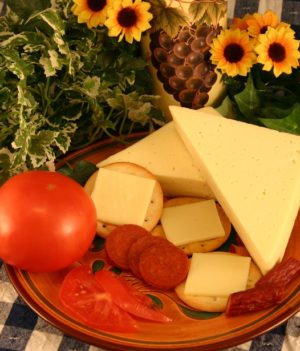
Earthy
A description of flavor – hearty, rustic taste and aroma. Many sheep’s and goat’s milk cheeses will taste earthy.
Edam
Edam cheese was first produced in the Netherlands after the town in which is made. It has a pale yellow interior and is usually encased within a crust of red paraffin wax. Its flavor is mild, salty and nutty at the early stage. It becomes sharper with aging. It is comparatively low in fat content when compared with other cheeses.
Emmental
A yellow, medium-hard Swiss cheese that originated in the area around Emmental in Switzerland. It has a mild, slightly fruity taste. It has large holes produced by the fermentation process which introduces air bubbles into the cheese.
Emulsifier
A substance or mixture used to create a smooth body and texture, particularly in processed cheeses.
Enzymes
Protein or protein-like compounds that act as catalysts in the breakdown of many substances. They act on the proteins such as casein in cheese to separate them from the whey. The ones used in cheesemaking include rennet and pepsin.
Esters
Fatty acid compounds responsible for flavor in cheese.
Epoisses de Bourgogne
This is a soft cow’s milk cheese produced in the village Époisses, France. It has a creamy, chewy and firm texture and a very pungent smell. It is categorized as a smear-ripened cheese washed in marc de Bourgogne and takes on a red-orange color as it takes 6 weeks to mature fully. Its flavor is spicy, sweet and salty.
Eyes
A hole within cheese caused by the formation of trapped gas as a result of fermentation
during the curing process. Eyes are typically found in Swiss-type cheeses. The natural bacteria consumes the lactic acid in the cheese. This releases carbon dioxide gas, which forms bubbles that become the holes in the cheese. Our Amish swiss cheese, made in Northeastern Ohio, is especially flavorful because of the longer aging process that it undergoes, at a higher temperature than younger cheeses. This produces larger eyes, which is sometimes seen as an indicator for better flavor.
Extra aged
A cheese that has been aged for between 2 and 7 years. It does not have to have a specified year. You will find that extra aged cheeses are highly flavored with deep, savory notes. They can sometimes become slightly crumbly as they age.
Are you enjoying the cheese glossary? What has been your favorite thing to learn about so far? Let us know in the comments below!
Cheese Glossary: The Letter D
Today our cheese glossary continues with the letter D!

Daisy
A cheese style, traditionally a 22-pound wheel of Cheddar, coated with wax and cheesecloth.
Danby
A cheese made in Vermont, made from raw goat milk. Danby is a hard, extra-aged cheese made in the style of Italian sardos like Piave and Asiago. It is aged for a minimum of six months and develops into a pure, dense white paste with a firm, smooth texture, and a rich flavour.
Draining
The process of separating the curds (solids) from the whey (liquids). This is the first step towards the cheese really beginning to take shape!
Deli horn
Cheese that has been formed into a small cylinder. This is most common with cheeses such as Colby, Colby Jack, and Pepper Jack.
Dipping
Transferring the curds from the whey into forms to set.
Direct-set
A cheese in which lactic acid is using to coagulate the curds rather than rennet.
Disk
Quite simply, a cheese that is formed in a disk shape. These include Brie and Camembert. Because of the shape, it allows a fairly quick aging process to take place.
Double cream cheese
This is a cheese made with milk that has at least 60% butterfat in it. Cream is added to the milk before the coagulation of the curds takes place.
Dry
A dry cheese is usually rather crumbly. In most cases, this would indicate a defect in the cheesemaking process, as most cheeses should still be moist even if they crumble slightly.
Dry matter
This refers to the dry elements of cheese that would be left if all of the moisture were removed. This includes proteins, milkfat, milk sugars and minerals A cheese with less dry matter will be softer. Most soft cheeses are around 50% dry matter and 50% water.
Do you have a term that you would like us to add to the cheese glossary? Let us know in the comments below!
Happy Labor Day weekend!
We want to wish all of our wonderful customers at Shisler’s Cheese House a very happy Labor Day weekend. Whether you’ve shopped with us once or every week, we appreciate all of you immensely.

If you’re hosting a barbecue, we have some posts that might help you. Check out our essential preparation checklist and our amazing barbecue marinades. We also have a list of summer cooking ideas that might help you to put together a brilliant party. For summer drinks inspiration, read our list of fun options that you can whip up easily at home or take to the beach. Create a charcuterie board or cheeseboard to impress your guests.
You could add extra cheese to your party with one of our gift boxes, perfect for sharing with family and friends. Our White Wine Collection and Beer Collection are ideal boxes for a great party. Check our gourmet foods section for snacks to keep you going whilst you go for a hike or simply explore your local area. There are so many options, we know that you’ll find something delicious.
Labor Day is also World Coconut Day
This year, Labor Day falls on September 2nd which is also World Coconut Day! There are so many ways that you could combine your celebrations.
- Serve pina coladas. This tropical cocktail is always a firm favorite and is fairly easy to make. Simply mix 1 part white rum, 1 part coconut cream, and 2 parts pineapple juice together. Add a handful of ice and blend for a truly refreshing drink. Don’t forget the cocktail umbrellas!
- Whip up a coconutty curry. Coconut milk is an amazing way to make a creamy curry, whether you’re making it with Indian or Thai flavors. Balance fiery chili against creamy coconut and you’ll be onto a winner.
- Crack open a real coconut. When National Today conducted a World Coconut Day survey, they found that 67% of people had never tried to open up a real coconut. A further 12% had tried and failed. The easiest way is to start by opening up one of the eyes of the coconut with a very sharp knife and draining out the coconut milk. Then wrap it in a towel and use a mallet to break apart the shell. Go gently at first and make sure that you have the towel in place to avoid shards of coconut flying everywhere. As long as you take care with this activity, it’s a really fun one to show children where coconut milk comes from! If you’re really struggling, there are lots of videos online to help you.
Whether you’re heading out to a parade or firework display, taking the opportunity to celebrate the humble coconut, or spending a day at the grill with family and friends, we hope that it is a brilliant day for you all. It’s one of our favorite days to spend with family before the fall begins.
How are you celebrating this Labor Day weekend? Let us know in the comments below; we’d love to hear all about it!
It’s National Red Wine Day tomorrow!
Tomorrow, August 28th, is National Red Wine Day!

According to the National Today Red Wine Day Survey, 15% of Americans love to enjoy wine with cheese. Judging by our customers, we’d say it was a lot more than that! If you’re one of those people, why not try our Red Wine Collection?
We’ve chosen a great selection of cheeses, perfect for pairing with red wines. This collection will serve up to 20 guests, so it’s perfect for those celebratory moments. Read on to find out which cheeses are included and our recommended wines for enjoying with them.
Asiago
Asiago is an Italian sister of Parmesan cheese. It is aged anywhere from three months up to a year and will vary from semi-firm to firm. It is delicious eaten with crackers and fruits, such as figs, pears, and plums. We recommend drinking a Cabernet Sauvignon with this cheese. The tanginess and salty, buttery qualities of the cheese will cut through the dark fruit, tannins, and spice of the wine.
Danish Blue Cheese
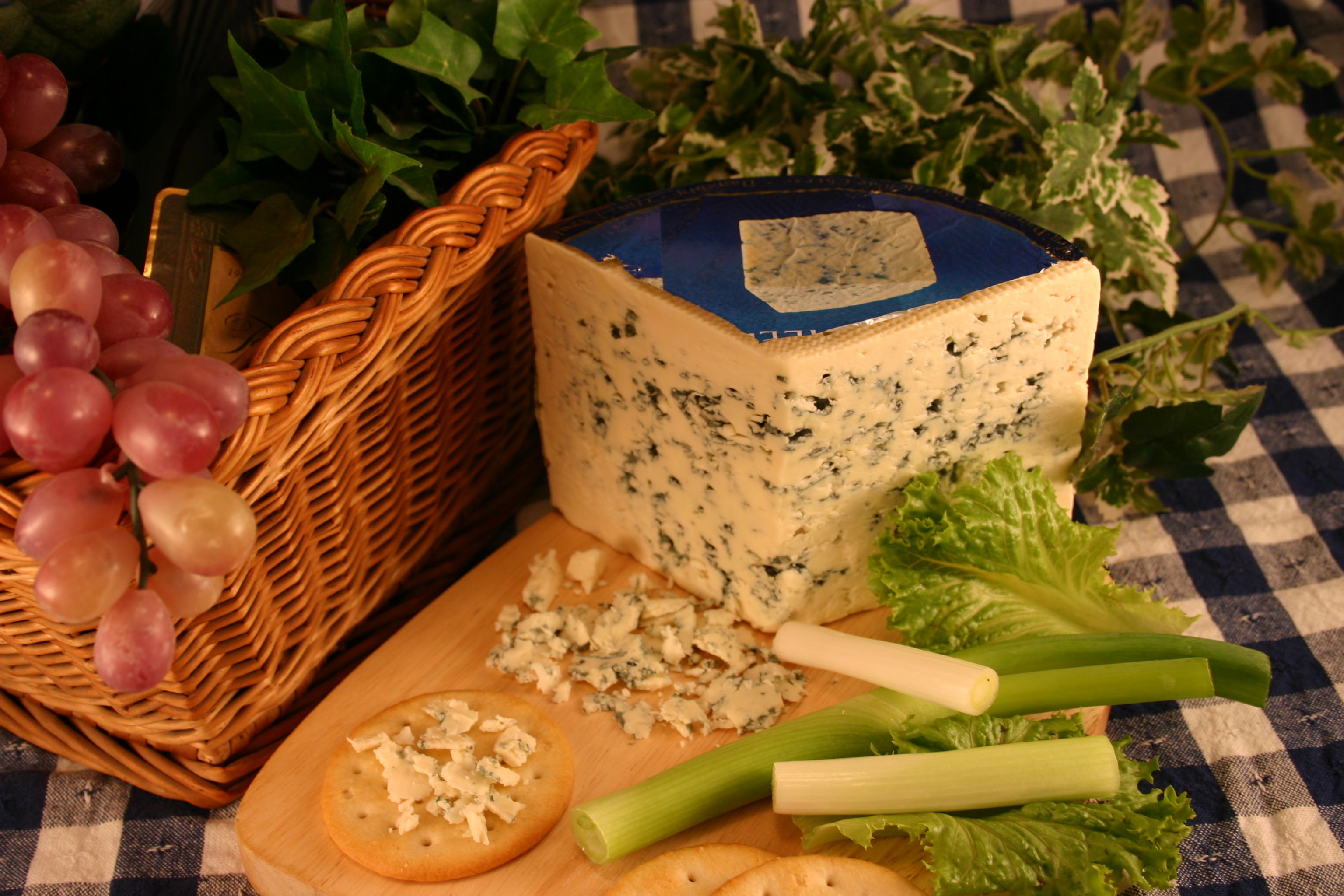
Blue cheeses are made with Penicillium cultures which create the blue veins this cheese is known for. They are aged in a temperature and moisture controlled environment to replicate a cave. Danish Blue is moderate in sharpness with a creamy finish. Try it with a sweet wine like Port to cut through the richness, or open a robust wine such as Shiraz if you are serving up a dish with blue cheese.
Gruyere
Gruyere is a sweet and nutty cheese, which develops a salty earthiness as it ages. Grenache or Syrah works well with Gruyere as they are not too rich and will allow the cheese to be the star of the show.
Romano Pecorino
Another Italian imported cheese, Romano Pecorino boasts a firm texture with a fantastic saltiness. Made from sheep’s milk, it has a very distinctive flavor that is an asset to any cheeseboard. For a full Italian experience, pair this cheese with a Chianti. This is a dry red wine with high acidity and plenty of fresh berries perfect for the salty flavor of this cheese.
If you are looking to add some extra cheeses to your red wine pairing board then Brick, Parmesan, Cheddar, Havarti,and Ohio Premium Swiss are all good options.
Ideas for celebrating National Red Wine Day
- Have a wine tasting. Ask your friends to each bring along a bottle of red wine and a cheese of their choice. Explore which go best together and enjoy pairing the flavors.
- Cook with red wine. It is a great addition to pies, stews, and even pasta dishes. Find a new recipe to have a go at or enjoy making an old favorite. We love to make a rich tomato sauce laced with red wine and slow cooked for maximum flavor.
- Have a glass of wine and a nap! Red wine contains melatonin which causes us to feel sleepy. If you don’t feel like socializing then this might be the quietest way to celebrate with a moment for yourself.
How will you be celebrating National Red Wine Day? Let us know in the comments below!
Cheese Glossary: The Letter C
We continue our cheese glossary with the letter C!
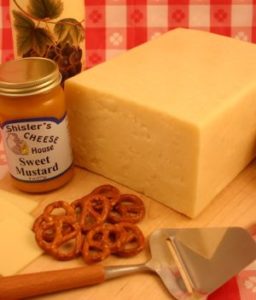
Casein
The main protein present in milk and, therefore, cheese. It makes up around 80% of the protein in cow’s milk, and is also highly present in sheep and buffalo milk.
Cheddar
Cheddar cheese has been produced in England since at least 1170. A pipe roll of King Henry II from that year records the purchase of 10,420 lb. at a farthing per pound. One suggestion is that Romans brought the recipe to Britain from the Cantal region of France, where it was adapted.
Central to the modernization and standardization of Cheddar was the nineteenth century Somerset dairyman Joseph Harding. He has been described as the father of Cheddar because of his technical developments, promotion of dairy hygiene and unremunerated propagation of modern cheese-making techniques.
Made in the classical way, it tends to have a sharp, pungent flavor, often slightly earthy. Its texture is firm, with farmhouse traditional Cheddar being slightly crumbly. The ideal quality of Cheddar was described by Joseph Harding in 1864 as “close and firm in texture, yet mellow in character or quality; it is rich with a tendency to melt in the mouth, the flavor full and fine, approaching to that of a hazelnut.”
“Cheddaring” refers to an additional step in the production of Cheddar cheese where, after heating, the curd is kneaded with salt, then is cut into cubes to drain the whey, then stacked and turned.
Chevre
Chevre (shev-ray) is a term which denotes a cheese made from the milk of goats, with the word chevre meaning goat in French. It is a fresh cheese which resembles cream cheese. This type of chevre tends to be slightly crumbly, creamy, and may have a strong goat flavor. Soft chevre is often herbed or spiced, and may be decorated with flowers or rosemary. Creamy chevres tend to have more complex flavors and an almost buttery feel. It softens beautifully when exposed to heat, although it does not melt in the same way that many cow cheeses do. Firmer chevres with rinds are sometimes baked in the oven to form a gooey warm cheese which is ideal for spreading on bread with roasted garlic, or alone. When chevre is served hot, it is known as chevre chaud.
Colby
Colby cheese is a semi-hard cow’s milk cheese native to the United States. Its flavor is more mild and creamy than the flavor of Cheddar. Washing the curds during the cheesemaking process reduces the acid content, making Colby cheese less tangy when it is finished. Colby also has a higher moisture content, and it tends to be much softer than cheddar.
Colby cheese was developed in the late 19th century by Joseph Steinwand, the son of a Wisconsin cheese maker. Steinwand named the cheese for the town in which the family had built their first dairy, and Colby, Wisconsin continues to celebrate Colby cheese today.
Curd
Curds are obtained by coagulating milk by adding an acidic agent such as lemon juice, vinegar or rennet. The milk proteins come together in solid masses separated from the liquid. You will also see curds form if you have milk that has gone past its best.
Cutting
This is the process of cutting into the curds to create more surface area so that the whey (liquid) can come away from the solids.
Cheese
We know what cheese is, of course, but we want our cheese glossary to be as thorough as possible! For the avoidance of doubt or if you are simply intrigued, the dictionary definition of cheese is “a food made from the pressed curds of milk, firm and elastic or soft and semi-liquid in texture”.
As always, if you have words that you would like us to define in our cheese glossary, let us know in the comments!
The World’s Most Expensive Cheeses
We recently brought you a post about the world’s most expensive wines, but we realized that it was the time to tell you about the world’s most expensive cheeses. These probably aren’t a cheese that you want to throw on your daily cheeseboard, but we can certainly dream about them!

World’s Most Expensive Cheeses: Pule
Pule is made from the milk of the Balkan donkey from Serbia. It costs a whopping $600 per pound, making it the most expensive cheese in the world! 25 liters of milk is used to make just one kilogram of the cheese. Low in fat, but high in vitamins and proteins, this cheese is said to boost the immune system. If you want to get your hands on a piece of this cheese, you have to order it as it isn’t available on the market!
World’s Most Expensive Cheeses: White Stilton Gold
This cheese is only slightly less expensive than Pule, coming in at $420 per pound. It is a British cheese that comes under a Protected Denomination Origin. It is a soft white cheese, rather than the blue of traditional stilton, and is actually made with real gold.
World’s Most Expensive Cheeses: Wyke Farms Reserve Cheddar
Another British cheese! Cheddar is often aged in caves and this expensive version is made in Somerset, in the south west of England. It is $200 per pound and, despite its incredible price, very popular. It is matured for at least 15 months and has both creaminess and nuttiness. The exact method for making it is a closely guarded secret.
Extra Old Bitto
This is a cheese sold exclusively in China, where you can find some of the oldest and most expensive cheeses that the world has to offer. It is aged for up to 10 years and costs around $120 per pound. It originated in Italy, where it is sometimes known as Bitto Storico. There are only 12 producers of this expensive cheese.
Caciocavallo Podolico
Another cheese of Italian origin, its name means ‘horse cheese’. However, it is not made from horse’s milk. The name, in fact, refers to the practice of horses carrying the cheese as it cured. The cheese would be suspended from the horse, almost like saddlebags. It is made from the raw milk of a rare breed of Italian cow called the Podolica. This cow spends some of its life living in the mountains, grazing on nettles, blueberries, rosehips, hawthorn, cornelian cherries, juniper, and wild strawberries. These flavors can sometimes come through in this unusual cheese. It is a hard cheese that is quite dry and sometimes has holes. The taste is described as vegetal and savory inside the rind that forms as it matures for a year.
Which of the world’s most expensive cheeses would you like to try? Have you actually tasted any of them? Let us know in the comments; we’d love to hear all about it!
Cheese Glossary: The Letter B
We continue our Cheese Glossary with the letter B!

A close relation of Swiss cheese, but Baby Swiss is made by substituting water for the milk’s whey in the cheesemaking process. This slows the bacterial action and produces smaller holes and milder flavor than Swiss cheese.
This cheese isn’t actually made from beer! It is a semi-soft combination of Limburger Cheese and Brick Cheese that has a very strong smell and taste. Best enjoyed with rye bread, sliced onion, and a glass of beer.
Brick
A medium-soft cheese made in the form of a large rectangular or brick shape, although it may also be named “brick” because the cheese curds are pressed with clay-fired bricks. It has a sweet, mild flavor when young but matures into a strong ripe cheese.
Bloomy rind
A light white powdery rind that develops on cheeses such as Brie and Camembert. It develops when the surface of the cheese is coated in a Penicillium spore.
Blue cheese
Any cheese that has had a culture of Penicillium added to it. This produces blue veins or spots through the cheese. They are often aged in a temperature- and moisture-controlled environment, such as a cave.
Brined
A cheese that has been brined has matured in saltwater. These include Feta, Halloumi, Gouda, and Gruyere. The salt is used to prevent the growth of bacteria, even in hot conditions. Most brined cheeses will taste clean, salty and acidic. Some brined cheeses are also known as washed rind.
Brushed
Sometimes cheeses are brushed, either by hand or by a machine, to help them stay moist as they ripen.
Burrata
A fresh Italian cheese made from mozzarella and cream. It has an outer shell of mozzarella, filled with stracciatella and cream. Stracciatella is a cheese made from Italian buffalo milk and is made up of small, creamy shreds.
Butterfat
Which terms would you like to see added to the cheese glossary? Let us know in the comments below!

